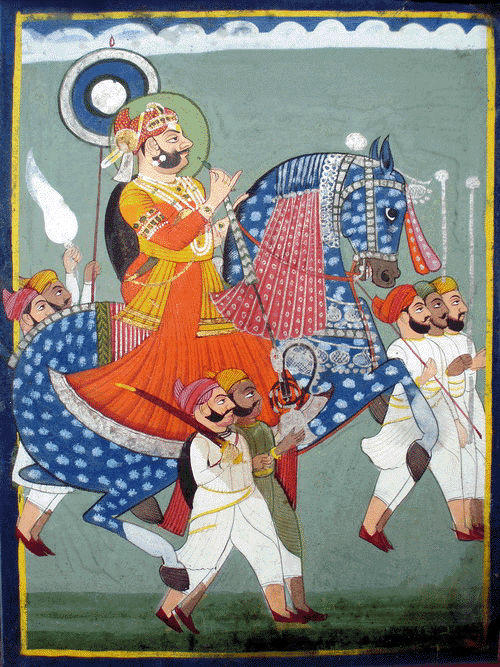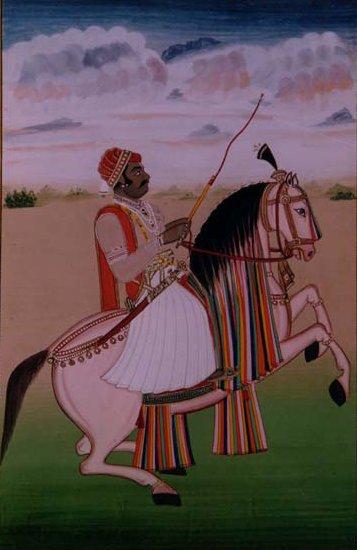
Join Amazon Prime - Watch Thousands of Movies & TV Shows Anytime - Start Free Trial Now
Raja Man Singh of Amber

Raja Man Singh of Amber (drawn c.1840)


The Rajputs had a significant impact on the Mughals in northwestern India, in Rajasthan and the surrounding region, but they were also key figures in Bengal and Orissa under the Mughals. In his book, The Rise of Islam and the Bengal Frontier, 1204–1760 author Richard M. Eaton describes the situation in Bengal just before Akbar's departure, and into the reign of his son, Jahangir. Eleven years before his death, Akbar had sent one of his best men into Bengal to strengthen and expand his presence there. This Rajput general was Raja Man Singh, a Rajputs, who had been an active leader in Akbar's court for some time in the northwest.
Raja Man Singh was the ruler of Amber, which later became known as Jaipur. Although he was a trusted general of Emperor Akbar's, and Akbar had named him as one of the Navaratnas, or nine gems of the royal court, Raja Man Singh remained a staunch devotee of Lord Krsna, and did not become an adherent of Akbar's Islamic faith.
In describing Akbar's late-in-life efforts to expand his presence in Bengal by deputing Raja Man Singh to take charge there, Richard M. Eaton writes the following:
"Akbar in early 1594 dispatched as governor of Bengal one of his most illustrious generals, the Rajput chieftain Raja Man Singh. After founding Rajmahal as his provincial capital in the delta's northwestern corner, the new governor led a vast army into Bhati in late 1595. Powerful Hindu chieftains like Kedar Rai, zamindar of Bhusna in Faridpur District, and Patkunwar Narain, the cousin of the raja of Kuch Bihar, chose refuge with ‘Isa Khan rather than submit to the Mughals.
In August 1597, ‘Isa Khan joined forces with Ma‘sum Khan Kabuli, the die-hard Mughal turncoat, and together they engaged Mughal naval forces with their own Bengali war boats in a battle that resulted in another Mughal defeat, in which Raja Man Singh's own son was killed. But this was the high tide of ‘Isa Khan's fortunes; two years later he died, apparently of natural causes. Sporadic resistance to Mughal authority nonetheless continued as ‘Isa Khan's Afghan followers flocked to one of his sons, Daud, while Kedar Rai joined with bands of maritime Arakanese, known as Maghs, who had been plundering Bengali communities far up the Meghna estuary.
In 1602, with a view to thwarting the rebellious ambitions of all these elements, Raja Man Singh established Dhaka as the center of his military operations in the east. Soon it would be Bengal's premier city. To be sure, the Mughals did not create the city ex nihilo. Since at least the mid fifteenth century, it had been an outpost of Muslim settlers, and one Mughal officer remarked that Dhaka, together with Gaur, Rajmahal, and Ghoraghat, had been among Bengal's "ancient forts." Hence it was probably for strategic reasons that, shortly after Mun‘im Khan took charge of the province in 1574, Dhaka was made the headquarters of a thana (Beng., thana), or military district, on the Mughals' far eastern frontier. Yet imperial authority there was still precarious, for in 1584 Dhaka's thanadar, or military administrator, had been captured and imprisoned by ‘Isa Khan.
By the time Raja Man Singh established himself in Dhaka, however, the balance of power had tipped in the Mughals' favor. From his new headquarters the governor, exploiting the disarray that followed ‘Isa Khan's death in 1599, mounted a vigorous campaign against the remaining "twelve chieftains." First, he worked on the Afghans loyal to ‘Isa Khan's son Daud, and then, in 1603, on Kedar Rai and the Arakanese. In all these campaigns the governor met with consummate success: he pushed back Daud to Sonargaon, defeated and killed Kedar Rai, expelled the Arakanese from the lower delta, and drove ‘Uthman Khan, the most powerful of the remaining Afghans, into the jungles of Mymensingh.
Alluding to the ascendancy of Mughal power in eastern Bengal between 1599 and 1603, Abu'l-fazl wrote that "the Rajah's mind being now at ease and having committed the thanahs to the charge of able men, he went to Dhaka." But the governor would not remain in the city for long; in early 1605, he left for Agra to attend to the ailing emperor, whose death was approaching. In that same year, Akbar died and was succeeded by his son, Jahangir.
It was in Jahangir's reign (1605–27) that the Mughal enterprise in Bengal passed from an ad hoc pursuit of rebels to the establishment of a regular administration. Initially, the new emperor's efforts to subdue Afghan chieftains proved ineffectual, especially with respect to the redoubtable ‘Uthman Khan, who remained firmly entrenched in Bengal's easternmost districts. But in May 1608, aiming to crush such elements once and for all, Jahangir appointed as governor ‘Ala al-Din Islam Khan, an extraordinarily able and determined commander.
A man about thirty-seven years of age at this time, Islam Khan enjoyed close ties with the emperor—the two had grown up together since childhood as foster-brothers—and possessed remarkable powers of self-discipline. Taking leave of the emperor, he moved down the Gangetic Plain at the head of an immense army of cavalry, artillery, and elephants, and a huge flotilla of war boats. After entering Bengal and pausing in Rajmahal, the army made its way through the jungles of the central delta, subdued rebellious chieftains on both sides of the Ganges-Padma river system, and finally reached Dhaka in 1610."
 A larger image of Akbar Fights with Raja Man Singh. |
 | |
| Akbar Fights with Raja Man Singh |
Raja Man Singh I of Amber City Palace Museum, Jaipur. |